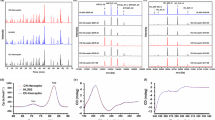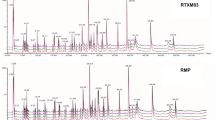Abstract
Due to the complex manufacturing process of therapeutic monoclonal antibodies, it is hardly possible to produce an identical copy of the original product (originator). Consequently, follow-on products (biosimilars) must demonstrate their efficacy being similar to the originator in terms of structure and function. During this process, a variety of analytical methods are required for this purpose. This study focuses on three particularly relevant analytical techniques: high-resolution mass spectrometry, fragment crystallisable (Fc) affinity chromatography, and two-dimensional peptide mapping. Each analytical method proved able to identify specific differences between originator and biosimilar. High-resolution mass spectrometry was used to characterize the glycan pattern. It was shown that a trastuzumab biosimilar did not have the G0:G0F sugar modification identified in the originator. The application of affinity chromatography to rituximab showed that originator and biosimilar interacted differently with the immobilized Fc receptor. Furthermore, 2D-HPLC peptide mapping demonstrated the influence of orthogonality of separation dimensions, leading to differentiation of a rituximab originator and biosimilar.
Graphical abstract





Similar content being viewed by others
Abbreviations
- mAbs:
-
Monoclonal antibodies
- CHO:
-
Chinese hamster ovary cells
- EMA:
-
European Medicines Agency
- API:
-
Active pharmaceutical ingredient
- HRMS:
-
High-resolution mass spectrometry
- 2D-HPLC:
-
Two-dimensional liquid chromatography
- ADCC:
-
Antibody-dependent cell-mediated cytotoxicity
- Fc:
-
Fragment crystallisable
References
Grilo AL, Mantalaris A. The increasingly human and profitable monoclonal antibody market. Trends Biotechnol. 2019;37(1):9–16. https://doi.org/10.1016/j.tibtech.2018.05.014.
Beck A, Wagner-Rousset E, Ayoub D, Van Dorsselaer A, Sanglier-Cianferani S. Characterization of therapeutic antibodies and related products. Anal Chem. 2013;85(2):715–36. https://doi.org/10.1021/ac3032355.
Beck A, Sanglier-Cianferani S, Van Dorsselaer A. Biosimilar, biobetter, and next generation antibody characterization by mass spectrometry. Anal Chem. 2012;84(11):4637–46. https://doi.org/10.1021/ac3002885.
Agency EM (2012) Guideline on similar biological medicinal products containing monoclonal antibodies – non-clinical and clinical issues. London
Shukla AA, Thommes J. Recent advances in large-scale production of monoclonal antibodies and related proteins. Trends Biotechnol. 2010;28(5):253–61. https://doi.org/10.1016/j.tibtech.2010.02.001.
Hossler P, Khattak SF, Li ZJ. Optimal and consistent protein glycosylation in mammalian cell culture. Glycobiology. 2009;19(9):936–49. https://doi.org/10.1093/glycob/cwp079.
Xie LQ, Zhang EH, Xu YP, Gao WY, Wang LL, Xie MHW, Qin PL, Lu LH, Li SP, Shen PC, Jiang WD, Liu S. Demonstrating analytical similarity of trastuzumab biosimilar HLX02 to Herceptin (R) with a panel of sensitive and orthogonal methods including a novel Fc gamma RIIIa affinity chromatography technology. BioDrugs. 2020;34(3):363–79. https://doi.org/10.1007/s40259-020-00407-0.
Sandra K, Vandenheede I, Sandra P. Modern chromatographic and mass spectrometric techniques for protein biopharmaceutical characterization. J Chromatogr A. 2014;1335:81–103. https://doi.org/10.1016/j.chroma.2013.11.057.
Reinders LMH, Klassen MD, Jaeger M, Teutenberg T, Tuerk J. Development of an analytical method to assess the occupational health risk of therapeutic monoclonal antibodies using LC-HRMS. Anal Bioanal Chem. 2018;410(11):2829–36. https://doi.org/10.1007/s00216-018-0966-1.
Hesse M, Meier H, Zeeh B (2012) Spektroskopische Methoden in der organischen Chemie; 8. Edition, Georg Thieme Verlag KG, Stuttgart, ISBN 978-3-13-576108-4
Chakrabarti A, Kervinen J, Müller E, Tanaka T, Muranaka K (2020) Analytical characterization of monoclonal antibodies with novel Fc receptor-based chromatography technique, monoclonal antibodies. In: Monoclonal antibodies. https://doi.org/10.5772/intechopen.95356
Vanhoenacker G, Vandenheede I, David F, Sandra P, Sandra K. Comprehensive two-dimensional liquid chromatography of therapeutic monoclonal antibody digests. Anal Bioanal Chem. 2015;407(1):355–66. https://doi.org/10.1007/s00216-014-8299-1.
Semard G, Peulon-Agasse V, Bruchet A, Bouillon JP, Cardinael P. Convex hull: a new method to determine the separation space used and to optimize operating conditions for comprehensive two-dimensional gas chromatography. J Chromatogr A. 2010;1217(33):5449–54. https://doi.org/10.1016/j.chroma.2010.06.048.
Gilar M, Olivova P, Daly AE, Gebler JC. Orthogonality of separation in two-dimensional liquid chromatography. Anal Chem. 2005;77(19):6426–34. https://doi.org/10.1021/ac050923i.
Camenzuli M, Schoenmakers PJ. A new measure of orthogonality for multi-dimensional chromatography. Anal Chim Acta. 2014;838:93–101. https://doi.org/10.1016/j.aca.2014.05.048.
Leonhardt J, Teutenberg T, Buschmann G, Gassner O, Schmidt TC. A new method for the determination of peak distribution across a two-dimensional separation space for the identification of optimal column combinations. Anal Bioanal Chem. 2016;408(28):8079–88. https://doi.org/10.1007/s00216-016-9911-3.
Delobel A, Cantais F, Catrain A, Dereux E, Van Vyncht G. Therapeutic antibody glycosylation analysis: a contract research organization perspective in the frame of batch release or comparability support. Methods Mol Biol. 2013;988:115–43. https://doi.org/10.1007/978-1-62703-327-5_8.
Lee J, Kang HA, Bae JS, Kim KD, Lee KH, Lim KH, Choo MJ, Chang SJ. Evaluation of analytical similarity between trastuzumab biosimilar CT-P6 and reference product using statistical analyses. mAbs. 2018;10(4):547–71. https://doi.org/10.1080/19420862.2018.1440170.
Damen CWN, Chen WB, Chakraborty AB, van Oosterhout M, Mazzeo JR, Gebler JC, Schellens JHM, Rosing H, Beijnen JH. Electrospray ionization quadrupole ion-mobility time-of-flight mass spectrometry as a tool to distinguish the lot-to-lot heterogeneity in N-glycosylation profile of the therapeutic monoclonal antibody trastuzumab. J Am Soc Mass Spectr. 2009;20(11):2021–33. https://doi.org/10.1016/j.jasms.2009.07.017.
Visser J, Feuerstein I, Stangler T, Schmiederer T, Fritsch C, Schiestl M. Physicochemical and functional comparability between the proposed biosimilar rituximab GP2013 and originator rituximab. BioDrugs. 2013;27(5):495–507. https://doi.org/10.1007/s40259-013-0036-3.
Jurczak W, Cohen S, Illidge TM, da Silva A, Amersdorffer J. Scientific rationale underpinning the development of biosimilar rituximab in hematological cancers and inflammatory diseases. Future Oncol. 2019;15(36):4223–34. https://doi.org/10.2217/fon-2019-0430.
Acknowledgements
We would like to thank the Federal Ministry for Economic Affairs and Energy for funding the INNO-KOM project “Sensitive method for the detection of airborne proteins” (49VF170039). Furthermore, we would like to thank Tosoh Bioscience for providing materials and samples.
Author information
Authors and Affiliations
Contributions
Lars M. H. Reinders: conceptualization, methodology, validation, formal analysis, investigation, data curation, writing—original draft, writing—review and editing, visualization, project administration, funding acquisition. Martin D. Klassen: conceptualization, methodology, writing—review and editing, supervision, funding acquisition. Thorsten Teutenberg: conceptualization, writing—review and editing, supervision, funding acquisition. Martin Jaeger: writing—review and editing, supervision. Torsten C. Schmidt: writing—review and editing, supervision.
Corresponding author
Ethics declarations
Conflict of interest
The authors declare no competing interests.
Additional information
Publisher's note
Springer Nature remains neutral with regard to jurisdictional claims in published maps and institutional affiliations.
Supplementary Information
Below is the link to the electronic supplementary material.
Rights and permissions
Springer Nature or its licensor holds exclusive rights to this article under a publishing agreement with the author(s) or other rightsholder(s); author self-archiving of the accepted manuscript version of this article is solely governed by the terms of such publishing agreement and applicable law.
About this article
Cite this article
Reinders, L.M.H., Klassen, M.D., Teutenberg, T. et al. Comparison of originator and biosimilar monoclonal antibodies using HRMS, Fc affinity chromatography, and 2D-HPLC. Anal Bioanal Chem 414, 6761–6769 (2022). https://doi.org/10.1007/s00216-022-04236-8
Received:
Revised:
Accepted:
Published:
Issue Date:
DOI: https://doi.org/10.1007/s00216-022-04236-8




